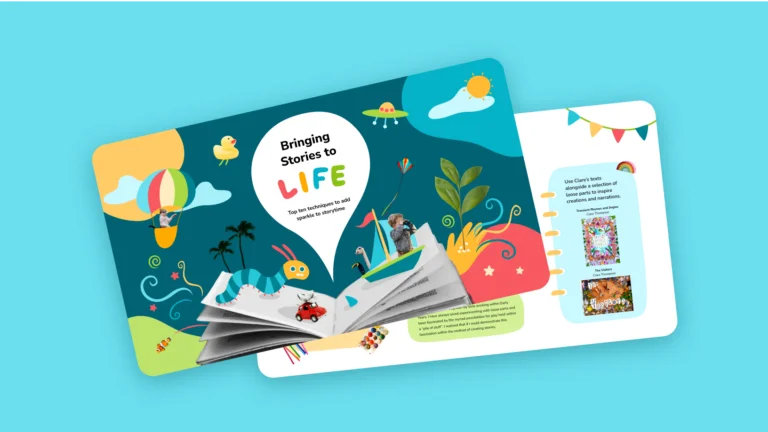Planning a Virtual Unit of Inquiry for the Early Years
Simon Sinek shared the importance of sharing your purpose in his inspiring and thought-provoking talk: Start with why – how great leaders inspire action. Therefore, when Toddle invited me to share the process and strategies for how I approached the creation of a virtual unit for 5-6-year-olds, I knew I should first start by explaining my ‘why’.
I created a virtual unit on Goods and Services on Toddle Community and by sharing my process of creating this unit, I want to:
- support the PYP Early Years learning community in implementing remote learning more meaningfully,
- share authentic examples of inquiry and play-based experiences that have worked in a real classroom which will bridge the gap between planning and execution,
- promote play as the primary driver for inquiry,
- develop age-appropriate inquiry-based learning experiences to set students up for success as they move to grade 1,

Before I start sharing the planning process, I think it’s important to consider ‘The Early Years Learner’. Loris Malaguzzi from Reggio Emilia says “Your Image of the Child is Where Teaching Begins”, so we must understand the needs and interests of our students to design authentic and meaningful experiences. The young learner is strong, intelligent and beautiful, with ambitious desires and requests and as teachers, we need to keep their choice and agency in the centre of the learning process.
The enhanced PYP emphasises the importance of play and the need to promote student agency and interests for the learner in the early years. When designing the unit plan for How We Organize Ourselves, I kept my EY learners at the center to ensure that my personal beliefs about how young children learn match the PYP enhancements, and they do!

As a trained early childhood teacher, with over 30 years of experience, I am an advocate for play! My image of a 5-year-old child is very similar to that of Loris Malaguzzi’s. Whilst designing the learning experiences, I thought a lot about the Reggio Emilia approach and the wise words of Malaguzzi. I aimed to “produce situations in which children learn by themselves, in which children can take advantage of their own knowledge and resources autonomously, and in which we guarantee the intervention of the adult as little as possible. We don’t want to teach children something that they can learn by themselves. We don’t want to give them thoughts that they can come up with by themselves. What we want to do is activate within children the desire and will and great pleasure that comes from being the authors of their own learning” (Malaguzzi, 1994).
Planning Process
Planning in the early years is like playing a game of snakes and ladders. Keeping play at the centre, I thought of the planning process as a game of snakes and ladders. Similar to the game, my planning process did not follow a linear progression – I found myself going back to add details, then leaping ahead- all to achieve a clear goal (which in my case was the ‘Goods and Services’ unit on Toddle Community’.
Click on the tiles to explore different steps of the process. As you go through this, you can consider what these “steps” might look like in your setting. Wonder about “have I considered agency, have I justified chosen concepts,” and so on.
I referred to many of the IB documents and found “Examining Learner Agency In my Setting” very useful.
I also asked myself:
- What previous learning experiences were most successful?
- How might they be adapted to suit the virtual learning environment?

I asked myself the following questions:
- What do my students already know about the central idea and the concept of ‘Goods and Services’?
- Since this is a virtual unit, what might parents need to know and understand about learning and teaching in the Early Years?
- What learning goals and success criteria could I map to this unit?
- What was puzzling me?
- How can we plan for an uncertain future?
- How can I design a plan for students I don’t know?
- How can one unit plan meet the needs of an unknown global learning community?
- How can I help EY teachers who have a range of experiences and different levels of understanding?
- How can teachers make their thinking about the planning process visible for parents doing virtual learning?
- How can teachers design a plan for families they don’t know yet?


The second question I asked was, how can student agency be supported in a virtual learning environment? According to the IBO, “Agency is present when students partner with teachers and members of the learning community to take charge of what, where, why, with whom and when they learn.”
Student choice, voice and ownership are integral to the learning experiences I designed. Students make choices by using a choice board, identifying the good or service they want to explore within their community, selecting how they want to showcase their learning, and by making decisions about what, where, when and with whom to play.

You can use the learning experiences I designed in your own units and share them with your families using the Toddle Classroom Feature. For when you’re back to in-person school, you can also explore how to Set up your own Market Stall with your students.
As I created this unit plan, I was thinking about the needs of:
- Beginning teachers who are new to PYP and planning for virtual learning
- Parents who have more than one child to supervise at home
- Parents whose home language is not English
- Our energetic five and six years old remote learning from home
- A classroom full of Early Years students
- Administrators who do not yet fully understand the value of play
- The learning experience ‘Services for the Community’ gives students an opportunity to role-play and consider different perspectives.
- ‘Through the Needs and Wants- Scavenger Hunt’, we get students to understand that needs and wants might vary.

- ‘Markets around the world’ helps students consider the needs and wants of producers and consumers.

The learning experience, Play with your parents can be used as a provocation for both students and parents. You will also find resources and instructions for parents in the learning experience planners, to support them.

The planning prompts can also be used to have discussions with colleagues as you consider ways of:
- Building in flexibility to respond to student's interests, inquiries, evolving theories and actions
- Integrating languages to support multilingualism
- Identifying opportunities for independent and collaborative learning, guided and scaffolded learning, and learning extension.
I wanted my central idea to also meet the following criteria:
- One sentence that expresses concisely an enduring understanding
- Substantial enough to generate in-depth inquiries
- Concept-driven
- Promotes the ability to think critically.
- Challenges and extends students’ prior knowledge
I asked myself:
- What is play?
- What does inquiry through play look like?
- How can parents support their children’s inquiry through play?
Through learning experiences like Set Up Shop, I explored play and inquiry. In Set Up Shop, students visit the school canteen to observe their school’s food service. This learning experience can also take place at home with students observing the food needs of their family. After their observation, students engage in dramatic play in their classrooms or homes.

- Is there a sense of focused engagement?
- Are there opportunities for independent and collaborative explorations?
- Do children have diverse opportunities and resources to creatively express themselves and their developing understandings?
- Is there a range of choices to inspire children to follow their own ideas?
- Are there inviting opportunities for collaboration in a social context?

As I reflected on learning spaces for the Goods and Services virtual learning unit on Toddle Community, I considered how indoor and outdoor learning spaces and materials in the early years promote play for inquiry. I thought of objects and artefacts that get kids interested, using powerful pictures and a wonder wall to pique their curiosity. Role-play learning experiences are also a good way to encourage children to have some ownership over their learning space. In the learning experience, Kindergarten bakery, students engage in playful inquiry, make choices and further develop ATL skills.
- Tuning In (The Provocation) -What do our students know?
- Finding Out - What might our students want to learn?
- Sorting Out- How can we use existing student knowledge?
- Going Further - How can we expand student thinking?
- Making Conclusions - How has student thinking changed?
- Taking Action - What can students do with their learning?

Through this unit, students would learn to:
- Become caring (towards family and community helpers)
- Think of new ways to help their community while following social distancing and safety norms
- Use different modes of communication to share their feelings and thoughts with family and classroom community
- Take risks to set up new learning spaces and opportunities at home

In the Goods and Services unit, students have multiple opportunities to take action. They have opportunities to engage in acts of kindness, participate in community service, produce goods to meet the needs of others.
 Through the market day, they are
encouraged to think of ways to earn money and donate to a chosen
charity.
Through the market day, they are
encouraged to think of ways to earn money and donate to a chosen
charity.
 I also reflected on ways for students to take action in a
remote or virtual learning environment. Therefore, students will be
given opportunities to be innovative and think of creative ways to
provide community services keeping safety and social distancing
norms in mind. Families may even be inspired to raise funds and
sponsor a child.
I also reflected on ways for students to take action in a
remote or virtual learning environment. Therefore, students will be
given opportunities to be innovative and think of creative ways to
provide community services keeping safety and social distancing
norms in mind. Families may even be inspired to raise funds and
sponsor a child.
For example, to unpack the concept of Form, students will focus on the first line of inquiry and examine the needs and wants of the community. They will engage in learning experiences such as the field trip to observe the needs of the school or home community and draw conclusions about goods and services needed to meet those needs. Mapping questions and learning experiences to key concepts helps us ensure that learning is truly transdisciplinary.

As important as it is for us to stay connected, it is even more important to create opportunities for students to belong to a learning community. Giving students opportunities to collaborate and share online will help them develop a sense of belonging. I used the Toddle Student App to create opportunities for students to share, like and comment on each other’s tasks.

I chose a variety of resources for teachers, parents and students. This included:
Human Resources
- Interviewing and playing with people students are living with
- Using junk and toys that are easily accessible at home
- Contacting people in the community using technology

Physical materials
- Things that can easily be found at home e.g. toys, loose parts, natural objects, real food, art and craft supplies,dress-up clothing, playdough, kitchen and food items, and recycled trash!
- Downloading free resources from the internet
- Going on Virtual field trips
- Using Toddle App to collaborate with teachers, students and parents
To be able to effectively create assessment strategies for this unit, I asked myself and you can ask yourself:
- What evidence can parents gather about their child's emerging knowledge, conceptual understandings and skills?
- During remote/home learning, how are teachers monitoring and documenting learning against learning goals and success criteria?
- How can we enable parents and young learners to use self-assessments and feedback to inform planning and next steps?

My personal favourite is using my modified version of De Bono’s coloured Thinking Hats for self-assessments. Each coloured hat has a different meaning attached to it, and students can reflect on their progress using these colours.
💛 Yellow= positive thoughts
⚫️ Black = challenges or problems
🔴 Red= feelings
🔵 Blue = PYP hat- notice and name the Learner Profile Attributes and ATLs
Click on the tiles to explore different steps of the planning process
As educators, we tend to give a lot of importance to our planners as opposed to the planning process. I really like Kath Murdoch’s response to Edna Sackson’s Planning for teaching’ post:
“A planner is a process – not a finished product…” One of my favourite moments in the planning process is when we ask : ‘So, what are our students revealing to us – and where do we go from here?’ This is true, responsive, organic planning that honours students’ voices. And it’s sooooo much more satisfying than simply coming up with ‘good activities’!
Discover these strategies in-depth in Cathie’s Toddle Talk here.












